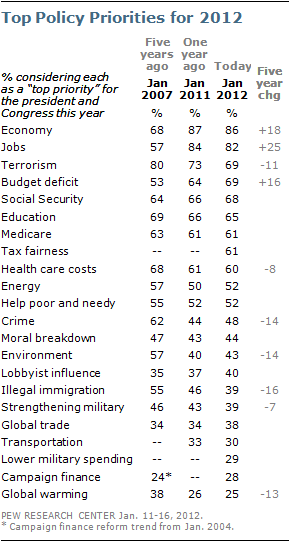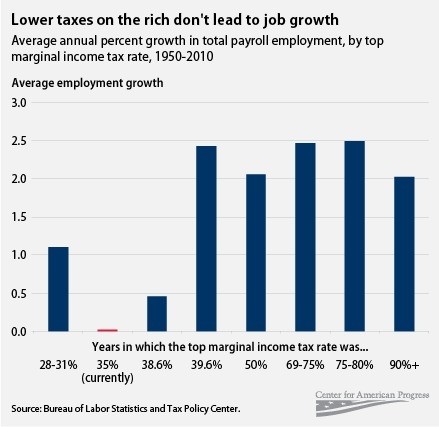Monthly Archives: January 2012
PEW: 2012 Policy Priorities
Economic issues continue to be the public’s highest priority as the 2012 State of the Union approaches. Fully 86% say that strengthening the economy should be a top priority for the president and Congress this year, and 82% rate improving the job situation as a top priority.
 The annual policy priorities survey by the Pew Research Center for the People & the Press, conducted Jan. 11-16 among 1,502 adults, finds that the federal budget deficit stands out as the fastest growing policy priority for Americans, largely because of increasing Republican concerns about the issue. Fully 69% rate reducing the budget deficit as a top priority — the most in any of the Pew Research Center’s annual policy priority updates going back to 1994.
The annual policy priorities survey by the Pew Research Center for the People & the Press, conducted Jan. 11-16 among 1,502 adults, finds that the federal budget deficit stands out as the fastest growing policy priority for Americans, largely because of increasing Republican concerns about the issue. Fully 69% rate reducing the budget deficit as a top priority — the most in any of the Pew Research Center’s annual policy priority updates going back to 1994.
Read full article at:PEW 2012 Priorities
Another reality check: taxes and job creation
I stumbled on this interesting chart. The data is reported to be from the Bureau of Labor Statistics.
The blogger writes: “In theory, the GOP is so committed to resisting tax hikes because it’s so committed to creating jobs. “The fact is you can’t tax the very people that we expect to invest in the economy and create jobs,” says Speaker John Boehner. But Michael Linden’s chart comparing average annual job creation at different marginal tax rates begs to differ:”
Blog post can be found at: http://www.washingtonpost.com/blogs/ezra-klein/post/tax-rates-and-job-creation-in-one-graph/2011/05/19/AGh9Z1oH_blog.html Continue reading
Fact Checking: Obama Adds More People to Foodstamps?
“Newt Gingrich claims that “more people have been put on food stamps by Barack Obama than any president in American history.” He’s wrong. More were added under Bush than under Obama, according to the most recent figures. Gingrich would have been correct to say the number now on food aid is historically high. The number stood at 46,224,722 personsas of October, the most recent month on record. And it’s also true that the number has risen sharply since Obama took office.
But Gingrich goes too far to say Obama has put more on the rolls than other presidents. We asked the U.S. Department of Agriculture’s Food and Nutrition service for month-by-month figures going back to January 2001. And they show that under President George W. Bush the number of recipients rose by nearly 14.7 million. Nothing before comes close to that.” Continue reading
PEW’s Journalism Center Offers Candidate Tracking Tools
Drawing on its analysis of campaign media coverage, the Pew Research Center’s Project for Excellence in Journalism has created a package of tools that let you track the volume and tone of coverage for each candidate, and the volume and tone of the conversation in Twitter. The tools also provide a gateway to data from other sources about media and public interest in the campaign. Use the tools
http://features.journalism.org/campaign-2012-in-the-media/tone-of-news-coverage/
Of course, the question for us here is the methodology used: what do they count and how do they count it?
Poverty In America
Report from SCHOOL OF PUBLIC AND ENVIRONMENTAL AFFAIRS INDIANA UNIVERSITY–
AT RISK: AMERICA’S POOR DURING AND AFTER THE GREAT RECESSION
Findings
1. The Great Recession has left behind the largest number of long-term unemployed people since records were first kept in 1948. More than four million Americans report that they have been unemployed for more than 12 months. Although the official rate of unemployment is declining, much of this apparent progress is attributable to the fact that many adults are giving up on the search for a job. The more telling indicator of an economy’s job-producing performance, the ratio of the number of employed people to the number of working-age adults (the “job-to-people” ratio), has improved only slightly since the Great Recession ended in June 2009. If the long-term unemployed lose their unemployment insurance benefits before the economy produces enough well-paying jobs to approach full employment, the ranks of the “new poor” will steadily swell
between now and 2017.
2. Large numbers of Americans are already poor. The official federal measure of poverty and a new “Supplemental Measure,” which accounts for several shortcomings in the official measure, both reveal a sobering fact: poverty in America is remarkably widespread. In 2010, about 46.2 million Americans were living in poverty according to the official measure, or about 15.1% of the U.S. population. The rate of poverty is slightly larger (16%) using the supplemental measure. The
five states with the highest rates of poverty are somewhat different according to the two measures (2009): Mississippi (23.2%), Arizona (21.3%), New Mexico (19.6%), Arkansas (19.1%), and Georgia (18.5%), according to the official measure; California (22.4%), Arizona (21.6%), Florida (19.5%), Georgia (18.8%), and Hawaii (18.0%), according to the supplemental measure. The supplemental measure accounts for geographical differences in the cost of living and thus gives more emphasis
to poverty in urban areas, where day-to-day living costs, especially housing, are higher than they are in rural areas. Continue reading


